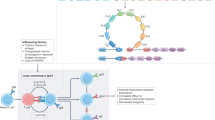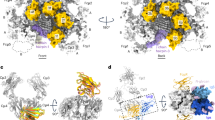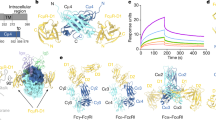Abstract
The FcεRI complex forms a high-affinity cell-surface receptor for the Fc region of antigen-specific immunoglobulin E (IgE) molecules. FcεRI is multimeric and is a member of a family of related antigen/Fc receptors which have conserved structural features and similar roles in initiating intracellular signalling cascades. In humans, FcεRI controls the activation of mast cells and basophils, and participates in IgE-mediated antigen presentation. Multivalent antigens bind and crosslink IgE molecules held at the cell surface by FcεRI. Receptor aggregation induces multiple signalling pathways that control diverse effector responses. These include the secretion of allergic mediators and induction of cytokine gene transcription, resulting in secretion of molecules such as interleukin-4, interleukin-6, tumour-necrosis factor-α and granulocyte-macrophage colony-stimulating factor. FcεRI is therefore central to the induction and maintenance of an allergic response and may confer physiological protection in parasitic infections.
This is a preview of subscription content, access via your institution
Access options
Subscribe to this journal
Receive 51 print issues and online access
$199.00 per year
only $3.90 per issue
Buy this article
- Purchase on Springer Link
- Instant access to full article PDF
Prices may be subject to local taxes which are calculated during checkout



Similar content being viewed by others
Notes
*Terms in italic are defined in the glossary on p. 39.
References
Kinet, J. P. The high-affinity IgE receptor (Fc epsilon RI): from physiology to pathology. Annu. Rev. Immunol. 17, 931– 972 (1999).
Weiss, A. & Littman, D. R. Signal transduction by lymphocyte antigen receptors. Cell 76, 263– 274 (1994).
Cambier, J. Antigen and Fc receptor signalling. The awesome power of the immunoreceptor tyrosine-based activation motif (ITAM). J. Immunol. 155, 3281–3285 (1995).
Reth, M. Antigen receptor tail clue. Nature 338, 383– 384 (1989).
Keown, M. B., Henry, A. J., Ghirlando, R., Sutton, B. J. & Gould, H. J. Thermodynamics of the interaction of human immunoglobulin E with its high-affinity receptor Fc epsilon RI. Biochemistry 37, 8863–8869 (1998).
Presta, L. et al. The binding site on human immunoglobulin E for its high affinity receptor. J. Biol. Chem. 269, 26368– 26373 (1994).
Henry, A. J. et al. Participation of the N-terminal region of Cepsilon3 in the binding of human IgE to its high-affinity receptor FcepsilonRI. Biochemistry 36, 15568–15578 (1997).
Robertson, M. W. Phage and Escherichia coli expression of the human high affinity immunoglobulin E receptor alpha-subunit ectodomain. Domain localization of the IgE-binding site. J. Biol. Chem. 268, 12736– 12743 (1993).
Letourneur, O., Sechi, S., Willette Brown, J., Robertson, M. W. & Kinet, J. P. Glycosylation of human truncated Fc epsilon RI alpha chain is necessary for efficient folding in the endoplasmic reticulum. J. Biol. Chem. 270, 8249 –8256 (1995).
Garman, S. C., Kinet, J. P. & Jardetzky, T. S. Crystal structure of the human high-affinity IgE receptor. Cell 95, 951– 961 (1998).
Alber, G., Miller, L., Jelsema, C. L., Varin-Blank, N. & Metzger, H. Structure function relationships in mast cell high affinity receptor for IgE. J. Biol. Chem. 266, 22613–22620 (1991).
Daeron, M. Fc receptor biology. Annu. Rev. Immunol. 15, 203–234 (1997).
Cohen, G. B., Ren, R. & Baltimore, D. Modular binding domains in signal transduction proteins. Cell 80, 237–248 (1995).
Scharenberg, A. M., Lin, S., Cuenod, B., Yamamura, H. & Kinet, J. P. Reconstitution of interactions between tyrosine kinases and the high affinity IgE receptor which are controlled by receptor clustering. EMBO J. 14, 3385–3394 (1995).
Jouvin, M. H. et al. Differential control of the tyrosine kinases Lyn and Syk by the two signaling chains of the high affinity immunoglobulin E receptor. J. Biol. Chem. 269, 5918–5925 (1994).
Nishizumi, H. & Yamamoto, T. Impaired tyrosine phosphorylation and Ca2+ mobilization, but not degranulation, in lyn-deficient bone marrow-derived mast cells. J. Immunol. 158, 2350–2355 (1997).
Costello, P. S. et al. Critical role for the tyrosine kinase Syk in signalling through the high affinity IgE receptor of mast cells. Oncogene 13, 2595–2605 (1996).
Zhang, J., Berenstein, E. H., Evans, R. L. & Siraganian, R. P. Transfection of Syk protein tyrosine kinase reconstitutes high affinity IgE receptor-mediated degranulation in a Syk-negative variant of rat basophilic leukemia RBL-2H3 cells. J. Exp. Med. 184, 71–79 (1996).
Vonakis, B. M., Chen, H., Haleem-Smith, H. & Metzger, H. The unique domain as the site on Lyn kinase for its constitutive association with the high affinity receptor for IgE. J. Biol. Chem. 272, 24072–24080 (1997).
Pribluda, V. S., Pribluda, C. & Metzger, H. Transphosphorylation as the mechanism by which the high-affinity receptor for IgE is phosphorylated upon aggregation. Proc. Natl Acad. Sci. USA 91, 11246–11250 (1994).
El-Hillal, O., Kurosaki, T., Yamamura, H., Kinet, J. P. & Scharenberg, A. M. syk kinase activation by a src kinase-initiated activation loop phosphorylation chain reaction. Proc. Natl Acad. Sci. USA 94, 1919– 1924 (1997).
Honda, Z. et al. Roles of C-terminal Src kinase in the initiation and the termination of the high affinity IgE receptor-mediated signaling. J. Biol. Chem. 272, 25753–25760 ( 1997).
Moarefi, I. et al. Activation of the Src-family tyrosine kinase Hck by SH3 domain displacement. Nature 385, 650– 653 (1997).
Thomas, M. L. The regulation of antigen-receptor signaling by protein tyrosine phosphatases: a hole in the story. Curr. Opin. Immunol. 11, 270–276 (1999).
Sheets, E. D., Holowka, D. & Baird, B. Membrane organization in immunoglobulin E receptor signaling. Curr. Opin. Chem. Biol. 3, 95– 99 (1999).
Zhang, W., Sloan-Lancaster, J., Kitchen, J., Trible, R. P. & Samelson, L. E. LAT: the ZAP-70 tyrosine kinase substrate that links T cell receptor to cellular activation. Cell 92, 83–92 ( 1998).
Finco, T. S., Kadlecek, T., Zhang, W., Samelson, L. E. & Weiss, A. LAT is required for TCR-mediated activation of PLCgamma1 and the Ras pathway. Immunity 9, 617– 626 (1998).
Facchetti, F. et al. Linker for activation of T cells (LAT), a novel immunohistochemical marker for T cells, NK cells, mast cells, and megakaryocytes: evaluation in normal and pathological conditions. Am. J. Pathol. 154, 1037–1046 (1999).
Salim, K. et al. Distinct specificity in the recognition of phosphoinositides by the pleckstrin homology domains of dynamin and Bruton's tyrosine kinase. EMBO J. 15, 6241–6250 (1996).
Rameh, L. E. et al. A comparative analysis of the phosphoinositide binding specificity of pleckstrin homology domains. J. Biol. Chem. 272, 22059–22066 (1997).
Rawlings, D. J. et al. Activation of BTK by a phosphorylation mechanism initiated by SRC family kinases. Science 271, 822– 825 (1996).
Scharenberg, A. M. & Kinet, J. P. PtdIns-3,4,5-P3: a regulatory nexus between tyrosine kinases and sustained calcium signals. Cell 94, 5–8 (1998).
Vanhaesebroeck, B., Leevers, S. J., Panayotou, G. & Waterfield, M. D. Phosphoinositide 3-kinases: a conserved family of signal transducers. Trends Biochem. Sci. 22, 267–272 (1997).
Turner, H., Reif, K., Rivera, J. & Cantrell, D. A. Regulation of the adapter molecule Grb2 by the FceR1 in the mast cell line RBL2H3. J. Biol. Chem. 270, 9500–9506 (1995).
Chen, R., Corbalan-Garcia, S. & Bar-Sagi, D. The role of the PH domain in the signal dependent membrane targeting of Sos. EMBO J. 16, 1351– 1359 (1997).
Nimnual, A. S., Yatsula, B. A. & Bar-Sagi, D. Coupling of Ras and Rac guanosine triphosphatases through the Ras exchanger Sos. Science 279, 560– 563 (1998).
Marshall, C. J. Ras effectors. Curr. Opin. Cell. Biol. 8, 197–204 (1996).
Tuosto, L., Michel, F. & Acuto, O. p95vav associates with tyrosine-phosphorylated SLP-76 in antigen-stimulated T cells. J. Exp. Med. 184, 1161–1166 (1996).
Crespo, P., Schuebel, K. E., Ostrom, A. A., Gutkind, J. S. & Bustelo, X. R. Phosphotyrosine-dependent activation of Rac-1 GDP/GTP exchange by the vav proto-oncogene product. Nature 385, 169–172 ( 1997).
Liu, S. K., Fang, N., Koretzky, G. A. & McGlade, C. J. The hematopoietic-specific adaptor protein gads functions in T-cell signaling via interactions with the SLP-76 and LAT adaptors. Curr. Biol. 9, 67–75 (1999 ).
Turner, H. & Cantrell, D. A. Distinct Ras effector pathways are involved in FcεR1 regulation of the transcriptional activity of Elk-1 and NFAT in mast cells. J. Exp. Med. 185, 43–57 (1997).
Turner, H., Gomez, M., Mckenzie, E., Kirchem, A., Lennard, A. & Cantrell, D. Rac-1 regulates nuclear factor of activated T cells (NFAT) C1 nuclear translocation in response to FcεR1 stimulation of mast cells. J. Exp. Med. 188, 527–537 (1998).
Roa, M., Paumet, F., Le Mao, J., David, B. & Blank, U. Involvement of the ras-like GTPase rab3d in RBL-2H3 mast cell exocytosis following stimulation via high affinity IgE receptors (Fc epsilonRI). J. Immunol. 159, 2815– 2823 (1997).
Hall, A. Rho GTPases and the actin cytoskeleton. Science 279 , 509–514 (1998).
Hutchinson, L. & McCloskey, M. Fcε R1 mediated induction of nuclear factor of activated T cells. J. Biol. Chem. 270, 16333–16338 ( 1995).
Rao, A., Luo, C. & Hogan, P. Transcription factors of the NFAT family. Annu. Rev. Immunol. 15, 707–748 (1997).
Putney, J. W. Jr & McKay, R. R. Capacitative calcium entry channels. BioEssays 21, 38 –46 (1999).
Parekh, A. B. & Penner, R. Store depletion and calcium influx. Physiol. Rev. 77, 901– 930 (1997).
Hoth, M. & Penner, R. Depletion of intracellular calcium stores activates a calcium current in mast cells. Nature 355, 353–356 (1992).
Paolini, R., Jouvin, M. H. & Kinet, J. P. Phosphorylation and dephosphorylation of the high affinity receptor for IgE immediately after receptor engagement and disengagement. Nature 353, 855–858 (1991).
Kimura, T. et al. Syk-independent tyrosine phosphorylation and association of the protein tyrosine phosphatases SHP-1 and SHP-2 with the high affinity IgE receptor. J. Immunol. 159, 4426– 4434 (1997).
Kimura, T., Sakamoto, H., Appella, E. & Siraganian, R. P. The negative signaling molecule SH2 domain-containing inositol- polyphosphate 5-phosphatase (SHIP) binds to the tyrosine-phosphorylated beta subunit of the high affinity IgE receptor. J. Biol. Chem. 272, 13991–13996 (1997).
Ottinger, E. A., Botfield, M. C. & Shoelson, S. E. Tandem SH2 domains confer high specificity in tyrosine kinase signaling. J. Biol. Chem. 273, 729 –735 (1998).
Lin, S., Cicala, C., Scharenberg, A. M. & Kinet, J. P. The Fc(epsilon)RIbeta subunit functions as an amplifier of Fc(epsilon)RIgamma-mediated cell activation signals. Cell 85, 985– 995 (1996).
Dombrowicz, D. et al. Allergy-associated FcRbeta is a molecular amplifier of IgE- and IgG-mediated in vivo responses. Immunity 8, 517–529 (1998).
Sandford, A. J. et al. Localisation of atopy and beta subunit of high-affinity IgE receptor (Fc epsilon RI) on chromosome 11q. Lancet 341, 332–334 (1993).
Adra, C. et al. Chromosome 11q13 and atopic asthma. Clin. Genet. 55, 431–437 (1999).
Shirakawa, T. et al. Association between atopy and variants of the β subunit of the high-affinity immunoglobulin E receptor. Nature Genet. 7, 125–129 (1994).
Hill, M. R. et al. Fc epsilon RI-beta polymorphism and risk of atopy in a general population sample. Br. Med. J. 311, 776– 779 (1995).
Yamaguchi, M. et al. IgE enhances mouse mast cell Fc(epsilon)RI expression in vitro and in vivo: evidence for a novel amplification mechanism in IgE-dependent reactions. J. Exp. Med. 185, 663– 672 (1997).
Takizawa, F., Adamczewski, M. & Kinet, J. P. Identification of the low affinity receptor for immunoglobulin E on mouse mast cells and macrophages as Fc gamma RII and Fc gamma RIII. J. Exp. Med. 176, 469–475 (1992).
Blank, U., Ra, C. S. & Kinet, J. P. Characterization of truncated alpha chain products from human, rat, and mouse high affinity receptor for immunoglobulin E. J. Biol. Chem. 266, 2639–2646 (1991).
Maurer, D. et al. Expression of functional high affinity immunoglobulin E receptors (Fc epsilon RI) on monocytes of atopic individuals. J. Exp. Med. 179, 745–750 ( 1994).
Maurer, D. et al. The high affinity IgE receptor (Fc epsilon RI) mediates IgE-dependent allergen presentation. J. Immunol. 154, 6285–6290 (1995).
Oettgen, H. C. et al. Active anaphylaxis in IgE-deficient mice. Nature 370, 367–370 ( 1994).
Ujike, A. et al. Modulation of immunoglobulin (Ig)E-mediated systemic anaphylaxis by low-affinity Fc receptors for IgG. J. Exp. Med. 189, 1573–1579 (1999).
Acknowledgements
We thank M.-H. Jouvin and other members of our laboratory for helpful advice and discussions. H.T. is an International Prize Travelling Fellow of the Wellcome Trust.
Author information
Authors and Affiliations
Rights and permissions
About this article
Cite this article
Turner, H., Kinet, JP. Signalling through the high-affinity IgE receptor FcεRI. Nature 402 (Suppl 6760), 24–30 (1999). https://doi.org/10.1038/35037021
Issue Date:
DOI: https://doi.org/10.1038/35037021
This article is cited by
-
The controversial effect of smoking and nicotine in SARS-CoV-2 infection
Allergy, Asthma & Clinical Immunology (2023)
-
Pathogenesis of allergic diseases and implications for therapeutic interventions
Signal Transduction and Targeted Therapy (2023)
-
A fully human anti-c-Kit monoclonal antibody 2G4 inhibits proliferation and degranulation of human mast cells
Molecular and Cellular Biochemistry (2023)
-
PD-1+ mast cell enhanced by PD-1 blocking therapy associated with resistance to immunotherapy
Cancer Immunology, Immunotherapy (2023)
-
Neuronal FcεRIα directly mediates ocular itch via IgE-immune complex in a mouse model of allergic conjunctivitis
Journal of Neuroinflammation (2022)
Comments
By submitting a comment you agree to abide by our Terms and Community Guidelines. If you find something abusive or that does not comply with our terms or guidelines please flag it as inappropriate.



